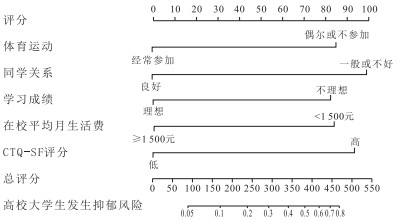Analysis of depressive symptoms and influencing factors among university students in Shandong Province
-
摘要:
目的 探讨山东省高校大学生抑郁症状现状及影响因素,为实施相应的干预措施提供参考依据。 方法 采用整群抽样法,选择2023年3月至2024年5月在山东省内高校就读的8 079名大学生为研究对象,以8/2定律随机分为训练集(6 463名)和验证集(1 616名)。分析大学生抑郁症状的影响因素,构建并验证大学生发生抑郁症状的风险预测模型。 结果 训练集大学生抑郁症状检出率为35.09%(2 268/6 463),其中轻度抑郁症状1 632名(71.96%)、中度抑郁症状545名(24.03%)、重度抑郁症状91名(4.01%);验证集高校大学生抑郁症状检出率为33.97%(549/1 616),其中轻度抑郁症状384名(69.95%)、中度抑郁症状127名(23.13%)、重度抑郁症状38名(6.92%)。训练集中抑郁症状检出组每天上网时间>3 h、偶尔或不参加体育运动、同学关系为一般或不好、经常喝含糖饮料、偶尔吃或不吃早餐、学习成绩不理想、在校每月生活费 < 1 500元、父母婚姻状况为离异或丧偶占比均高于未检出组(χ2值分别为1 193.85,1 584.41,1 115.10,826.00,1 424.05,924.58,803.68,797.65)、中文版儿童期创伤问卷(CTQ-SF)评分亦高于未检出组(t=98.48)(P值均<0.05)。Logistic回归分析结果显示,体育运动、同学关系、学习成绩、在校平均每月生活费、CTQ-SF评分为高校大学生发生抑郁症状的影响因素(OR值分别为3.87,4.82,3.63,3.75,4.39,P值均<0.05)。训练集模型预测高校大学生检出抑郁症状的灵敏度为89.0%(95%CI=87.6%~90.2%),特异度为93.0%(95%CI=92.2%~93.7%),曲线下面积为0.9(95%CI=0.8~1.0);验证集模型高校大学生发生抑郁症状的灵敏度为87.6%(95%CI=84.5%~90.1%),特异度为91.3%(95%CI=89.4%~92.9%),曲线下面积为0.9(95%CI=0.8~1.0)。 结论 山东省大学生抑郁症状检出率较高,构建风险预测模型有助于早期甄别大学生抑郁症状发生风险。 Abstract:Objective To explore the prevalence and influencing factors of depressive symptoms among university students in some universities in Shandong Province, so as to provide a theoretical reference for implementing corresponding intervention measures. Methods A cluster-sampling method was used to select 8 079 university students studying in universities in Shandong Province from March 2023 to May 2024 as the research subjects. They were randomly divided into a training set (6 463) and a validation set (1 616) according to the 8/2 ratio. The influencing factors of depression among university students were analyzed, and a risk prediction model for depression among university students was constructed and validated. Results In the training set of university students, the detection rate of depression was 35.09%(2 268/6 463), with 1 632 cases (71.96%) of mild depression, 545 cases (24.03%) of moderate depression, and 91 cases (4.01%) of severe depression. In the validation set of university students, the detection rate of depression was 33.97% (549/1 616), with 384 cases (69.95%) of mild depression, 127 cases (23.13%) of moderate depression, and 38 cases (6.92%) of severe depression. In the training set, the proportions of those who surfed the Internet for more than 3 h/d, occasionally or did not participate in physical exercise, had average or poor relationships with classmates, often drank sugary drinks, occasionally or did not have breakfast, had unsatisfactory academic performance, had an average monthly living expense of less than 1 500 yuan on campus, and had divorced or widowed parents in the depression-detected group were all higher than those in the undetected group(χ2=1 193.85, 1 584.41, 1 115.10, 826.00, 1 424.05, 924.58, 803.68, 797.65, P < 0.05). The scores of the Chinese version of the Childhood Trauma Questionnaire (CTQ-SF) in the depression-detected group were also higher than those in the undetected group(t=98.48, P < 0.05). The results of Logistic regression analysis showed that physical exercise, classmate relationships, academic performance, average monthly living expenses on campus, and CTQ-SF scores were influencing factors for depression among university students(OR=3.87, 4.82, 3.63, 3.75, 4.39, P < 0.05). The sensitivity of the model in the training set for predicting depression among university students was 89.0%(95%CI=87.6%-90.2%), the specificity was 93.0% (95%CI=92.2%-93.7%), and the area under the curve was 0.9(95%CI=0.8-1.0); the sensitivity of the model in the validation set for predicting depression among university students was 87.6%(95%CI=84.5%-90.1%), the specificity was 91.3%(95%CI=89.4%-92.9%), and the area under the curve was 0.9(95%CI=0.8-1.0). Conclusions The high detection rate of depressive symptoms among university students in some universities in Shandong Province warrants attention. Constructing a risk prediction model is helpful for early identifying the risk of depression among university students. -
Key words:
- Depression /
- Mental health /
- Regression analysis /
- ROC curve /
- Students
1) 利益冲突声明 所有作者声明无利益冲突。 -
表 1 训练集中抑郁症状检出组与未检出组被试一般资料分布比较
Table 1. Comparing the general data of the occurrence group and the non-occurrence group with depressive symptoms in the training set
因素 检出组(n=2 268) 未检出组(n=4 195) χ2值 P值 性别 男 1 025(45.19) 1 974(47.06) 2.05 0.15 女 1 243(54.81) 2 221(52.94) 民族 汉族 1 954(86.16) 3 625(86.41) 0.08 0.77 其他 314(13.84) 570(13.59) 父亲受教育程度 初中及以下 712(31.39) 1 651(39.36) 40.25 <0.01 高中及以上 1 556(68.61) 2 544(60.64) 母亲受教育程度 初中及以下 872(38.45) 1 763(42.03) 7.81 <0.01 高中及以上 1 396(61.55) 2 432(57.97) 每天上网时间/h ≤3 726(32.01) 3 189(76.02) 1 193.85 <0.01 >3 1 542(67.99) 1 006(23.98) 体育运动 经常参加 765(33.73) 3 481(82.98) 1 584.41 <0.01 偶尔或不参加 1 503(66.27) 714(17.02) 同学关系 良好 812(35.80) 3 264(77.81) 1 115.10 <0.01 一般/不好 1 456(64.20) 931(22.19) 早餐食用情况 经常吃 751(33.11) 3 372(80.39) 1 424.05 <0.01 偶尔吃或不吃 1 517(66.89) 823(19.62) 含糖饮料 经常喝 1 375(60.63) 1 025(24.43) 826.00 <0.01 不经常喝 893(39.37) 3 170(78.57) 学习成绩 理想 752(33.16) 3 029(72.21) 924.58 <0.01 不理想 1 516(66.84) 1 166(27.79) 在校平均月生活费/元 ≥1 500 789(34.79) 2 987(71.20) 803.68 <0.01 <1 500 1 479(65.21) 1 208(28.80) 父母婚姻状况 正常 1 376(60.67) 3 784(90.20) 797.65 <0.01 离异/丧偶 892(39.33) 411(9.80) 注: ()内数字为构成比/%。 表 2 高校大学生抑郁症状影响因素Logistic回归分析(n=6 463)
Table 2. Logistic regression analysis of the influencing factors of depressive symptoms among university students(n=6 463)
因素 β值 标准误 Wald χ2值 OR值(95%CI) P值 体育运动 1.35 0.42 10.53 3.87(1.70~8.80) <0.01 同学关系 1.57 0.47 11.44 4.82(2.12~10.97) <0.01 学习成绩 1.29 0.51 6.42 3.63(1.60~8.26) <0.01 在校平均月生活费 1.32 0.44 9.10 3.75(1.65~8.52) <0.01 CTQ-SF评分 1.48 0.37 15.81 4.39(1.93~9.98) <0.01 -
[1] LI W, ZHAO Z, CHEN D, et al. Prevalence and associated factors of depression and anxiety symptoms among college students: a systematic review and Meta-analysis[J]. J Child Psychol Psychiatry, 2022, 63(11): 1222-1230. doi: 10.1111/jcpp.13606 [2] SHOREY S, NG E D, WONG C. Global prevalence of depression and elevated depressive symptoms among adolescents: a systematic review and Meta-analysis[J]. Br J Clin Psychol, 2022, 61(2): 287-305. doi: 10.1111/bjc.12333 [3] TAUBMAN D S, HEININGER W, SALAZAR S, et al. Depression on college campuses conference: addressing an evolving crisis[J]. Acad Psychiatry, 2022, 46(3): 359-363. doi: 10.1007/s40596-021-01575-z [4] GARCIA C, BUSCH D W, RUSSELL N G. Best practices for depression screening among college students: a literature review[J]. J Psychosoc Nurs Ment Health Serv, 2024, 62(6): 13-17. doi: 10.3928/02793695-20231024-02 [5] ZHOU C, GAO M, SHI X, et al. Suicidal behavior, depression and loneliness among college students: the role of school belonging[J]. Psychol Health Med, 2023, 28(6): 1520-1526. doi: 10.1080/13548506.2022.2113105 [6] ASHER B M P C, PATTERSON S W P D, MAGUIN P E, et al. Depression and anxiety among college students: understanding the impact on grade average and differences in gender and ethnicity[J]. J Am Coll Health, 2023, 71(4): 1091-1102. doi: 10.1080/07448481.2021.1920954 [7] CAMPO-ARIAS A, PINTO-VASQUEZ H L, PEDROZO-PUPO J C. Confirmatory factor analysis of the Brief Spanish Zung Self-rating Depression Scale in patients with chronic pulmonary obstructive disease[J]. Perspect Psychiatr Care, 2022, 58(3): 889-893. doi: 10.1111/ppc.12868 [8] 张敏. 中文版儿童期虐待问卷信度及效度评价[J]. 中国公共卫生, 2011, 27(5): 669-670.ZHANG M. Reliability and validity of the Chinese version of CTQ-SF[J]. Chin J Public Health, 2011, 27(5): 669-670. (in Chinese) [9] 孙景芬, 董雪, 刘中伟, 等. 沈阳市某两所高校大学生抑郁现况及其影响因素调查分析[J]. 中国卫生统计, 2021, 38(6): 905-908.SUN J F, DONG X, LIU Z W, et al. Investigation and analysis of depression and its influencing factors in two universities in Shenyang[J]. Chin J Health Stat, 2021, 38(6): 905-908. (in Chinese) [10] CHEN C, BEAUNOYER E, GUITTON M J, et al. Physical activity as a clinical tool against depression: opportunities and challenges[J]. J Integr Neurosci, 2022, 21(5): 132. doi: 10.31083/j.jin2105132 [11] LUO J, CAO W, ZHAO J, et al. The moderating role of optimism between social trauma and depression among Chinese college students: a cross-sectional study[J]. BMC Psychol, 2023, 11(1): 270. doi: 10.1186/s40359-023-01314-z [12] TERRELL K R, STANTON B R, HAMADI H Y, et al. Exploring life stressors, depression, and coping strategies in college students[J]. J Am Coll Health, 2024, 72(3): 923-932. doi: 10.1080/07448481.2022.2061311 [13] 王超, 吕军城, 张艺琳, 等. 山东省中学生抑郁症状的相关因素[J]. 中国心理卫生杂志, 2023, 37(4): 318-325.WANG C, LV J C, ZHANG Y L, et al. Related factors of depressive symptoms among middle school students in Shandong Province[J]. Chin J Ment Health, 2023, 37(4): 318-325. (in Chinese) [14] 王浩, 周怡, 戴品远, 等. 浙江省中学生焦虑抑郁症状共病状况分析[J]. 中华流行病学杂志, 2023, 44(12): 1921-1927.WANG H, ZHOU Y, DAI P Y, et al. Comorbidity of anxiety symptoms and depression symptoms among middle and high school students in Zhejiang Province[J]. Chin J Epidemiol, 2023, 44(12): 1921-1927. (in Chinese) [15] 顾曼丽, 姜茂敏, 李志祥, 等. 教师偏见对我国高校大学生焦虑、抑郁的影响[J]. 中国卫生事业管理, 2023, 40(5): 380-385.GU M L, JIANG M M, LI Z X, et al. Study on the influence of teacher prejudice on the anxiety and depression of college students in China[J]. Chin J Health Manage, 2023, 40(5): 380-385. (in Chinese) [16] 和红, 罗月. 北京高校大学生抑郁状况及其影响因素研究[J]. 现代预防医学, 2015, 42(7): 1261-1264, 1299.HE H, LUO Y. Analysis on depression status and influence factors of university students in Beijing[J]. Mod Prev Med, 2015, 42(7): 1261-1264, 1299. (in Chinese) [17] QIN Q, JIANG Y, MEI X, et al. The effect of childhood trauma on depression in college students: a moderated mediation model[J]. J Affect Disord, 2024, 352: 490-497. [18] 侯佳璐, 康凤英, 赵娟, 等. 青少年抑郁症风险预测模型的构建及验证[J]. 护理研究, 2022, 36(9): 1529-1536.HOU J L, KANG F Y, ZHAO J, et al. Construction and validation of the depression risk prediction model in adolescents[J]. Nurs Res, 2022, 36(9): 1529-1536. (in Chinese) -







 下载:
下载:

